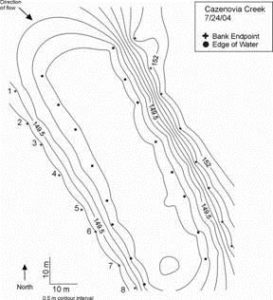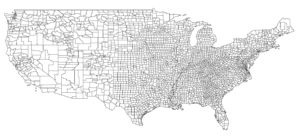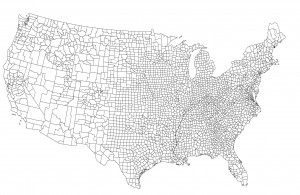SPECIFICATIONS FOR MANUSCRIPT
MIDDLE STATES GEOGRAPHER
Download the Guidelines (updated 10/2015)
Deadlines and Peer Review
Initial submission: Manuscripts for the Middle States Geographer are accepted at any time. Please email your manuscript submission file to the journal editors: Adam Kalkstein (Adam.Kalkstein@usma.edu) or Paul Marr (pgmarr@ship.edu). Tables and figures, along with their corresponding captions and titles, should be presented in order at the end of the manuscript. Table and figure formatting is described in detail below. Digital files of the initial submission may be in either Microsoft Word or Adobe PDF format. Manuscripts will undergo a normal peer review and will be returned to authors within eight to ten weeks. Manuscripts that are accepted for publication should be revised to consider reviewer comments where appropriate. Acceptance for publication is at the discretion of the editors.
Submission of a revised manuscript: One digital file of the revised manuscript should be returned to Adam Kalkstein (Adam.Kalkstein@usma.edu) or Paul Marr (pgmarr@ship.edu) within four weeks of receiving the reviewers’ comments. Again, tables and figures, along with their corresponding captions and titles, should be presented in order at the end of the revised manuscript. Digital files of the revised manuscript must be in Microsoft Word ONLY. Putting together a manuscript is difficult and some slight deviations from the manuscript guidelines are inevitable. However, the editors reserve the right to return manuscripts to the authors at any point in the review process until substantial deviations from the manuscript guidelines have been addressed.
Manuscript Guidelines
1. Manuscript Length
Manuscripts must not exceed ten (10) pages, including all figures, tables, endnotes, and references based on the following conditions:
- single spaced
- Times New Roman 10 point font
- 1 inch top and bottom margins, 1 inch left and right margins
- do not right justify (we will do this during copy-editing)
- single-column format
Longer manuscripts will only be accepted with prior approval from the editors. All other manuscripts not meeting the page limit requirements will be returned to the authors for revision. Given these requirement it is important that authors consider the size and number of tables/graphics prior to manuscript submission.
2. Paper Title and Authors
Follow this format:
PAPER TITLE (all capitals, bold, 12 point)
Author (your name, 10 point)
Department
University
City, State, Zip
In the case of multiple authors, indicate the corresponding author using a superscript * after the name. Multiple authors from the same institutions should use a superscript numbering scheme for their address as follows:
K.M. Monahan*1, K. Miller2, K.N. Irvine1, and J. Whitney3
1Department of Geography and Planning
2Department of Earth Sciences
State University College at Buffalo
1300 Elmwood Avenue
Buffalo, NY 14222
3Natural Resources Conservation Service
50 Commerce Way
East Aurora, NY 14052
3. Abstract and Keywords
Type the word ABSTRACT: (all capitals, bold, italics, 12 point), space two spaces and then start the abstract text (in italics, 10 point). Do not indent the first line of the abstract. Abstracts should be a maximum of 250 words. Single space after the abstract and then type the word Keywords: (bold, italics, 10 point) and type up to five keywords (in italics, 10 point) that describe the manuscript. Double space after the keywords and then begin the body of the manuscript.
Example: MEASURING SMALL-TOWN HEAT ISLANDS
Samuel Miller* and Jennifer Stone
Department of Geography
Upton University
12 University Drive
Upton, NY 55555
ABSTRACT: While urban heat islands have been the subject of numerous studies, little research has been focused on the heat island effects of small towns. Five small towns (population less than 5000) in northern New York were investigated to determine if localized heating was present, and if so, the magnitude of the heating. Four of the five study towns exhibited pronounced localized heating at a magnitude that was approximately twice what was expected. These results suggest that the heat island effect seen so prominently in large urban settings is much more widespread than previously thought.
Keywords: Small-town, heat island, New York
4. Text Headings
FIRST-LEVEL SUBHEADINGS WITHIN THE TEXT SHOULD BE CENTERED,
BOLD, AND ALL CAPITALS (12 POINT)
First-level headings are 12 point, all capital letters, bold, and centered. There is one blank line below first-level headings.
Second-level Subheadings
Second level subheadings the text should start at the left-hand margin and be bold with important words capitalized (10 point). There are no blank lines below second-level subheadings.
Third-level subheadings
Third level subheadings, if any, are bold, italics, beginning at the left-hand margin, with only the first word capitalized (10 point). Third-level subheading are in-line with the paragraph text.
5. Tables
Tables should be presented at the end of the manuscript in the order they appear in the text. The only lines of separation in the table should be horizontal (i.e. no vertical lines). A table number (Arabic numbers) and title should appear at the top of the table. Important words in the table title should be capitalized. There should not be a period at the end of the table title.
Example:
| Table 2. Volume of Material Eroded and Deposited Over Time | ||||
|
Cazenovia Creek |
Summer-Fall
7/24/04-12/15/04 |
Winter-Spring
12/15/04-5/31/05 |
Summer-Fall
5/31/05-11/14/05 |
Winter-Spring
11/14/05-4/12/06 |
| Erosion (m3) | 176 | 9 | 765 | 26 |
| Deposition (m3) | 46 | 863 | 8 | 290 |
Tables should be created using the table function in your word processing software. Tables should not use tabs or spaces for alignment. Please avoid using overly large or complex tables. In all cases, tables should fit on a single page.
6. Illustrations
High-quality illustrations (maps, graphs, and other illustrations) should be presented at the end of the manuscript in the order they appear in the text. Type figure captions below the illustrations. Do not use text boxes or caption functions. Figure captions should be left justified. Capitalize the word “Figure x.” and the first word of the caption and end the caption with a period. Graphics must be high-quality. Lettering must be of a reasonable size that would still be clearly legible (8 point or larger) upon reduction, and consistent within each figure and set of figures. Avoid full page maps and graphics whenever possible. Please suggest a location for each graphic and table.

Figure 5. Cazenovia Creek morphology.
Poor quality graphics will not be reproduced in the journal and may result in rejection of the manuscript. It is advisable to design graphics so that they comfortably fit within the margins of the manuscript. Graphics should be a minimum of 300 dpi. Color graphics are free of charge.
Color graphics reproduce differently based on the color-space used. Bold, bright colors are best preserved using CMYK color-space, while muted and pastel colors are best achieved using RGB color-space. Since manuscripts are published in PDF format, you can check that your color graphics will reproduce correctly by saving and examining them in PDF format.
Example:

Please generate your own graphics whenever possible, as there may be copyright issues with graphics produced by someone else. If graphics are obtained from other sources, please include a notation of the source either in the graphic caption or below the graphic.
Please use projected map data, especially when including maps that cover large areas, such as regions, countries, or continents. The editors reserve the right to withhold publication of a manuscript until maps and graphics meet the journal’s standards.
Unprojected
Projected
Do not imbed Excel graphics into your manuscripts. Please save these graphics as images. Excel graphics are notoriously difficult to work with during the copy-editing process, especially resizing. Neat-lines are helpful but not strictly necessary depending on the specific graphic and the content, use your discretion.
7. References
The heading for the References section should be typed like first-level subheadings. References should be typed using the following as a style guide (or consult the Annals of the Association of American Geographers):
Examples:
Thorn, C.E. 1988. Introduction to Theoretical Geomorphology. Boston: Unwin Hyman.
Woodhouse, W.W. 1978. Dune Building and Stabilization with Vegetation. Special Report No. 3 Ft. Belvoir Virginia: U.S. Army Corps of Engineers, Coastal Engineering Research Center.
Butzer, K.W. 1989. Cultural Ecology. In Geography in America, ed. G.L. Gaile and C.J. Willmott, pp. 192-208. Columbus: Merrill.
Mann, R., Sparling, E., and Young, R.A. 1987. Regional Economic Growth from Irrigation Development: Evidence from Northern High Plains Ogallala Groundwater Resource. Water Resources Research. 23:1711-1716.
Hardy, D. R. et al. 1998. Annual and daily meteorological cycles at high altitude on a tropical mountain. Bulletin of the American Meteorological Society. 79(9): 1899-1913.
Please use volume and issue if available and et al. for more than three (3) authors. References from the same author should be ordered by date in ascending order. References should be single-spaced (with a single line between successive references). In the text, references should be listed according to the following style:
“It is one of the oldest tourism resorts in the country and is severely affected by pollution and coastal erosion (Nakatani et al., 1994; Tampoe, 1988).”
OR
“According to Sauer (1979), household waste was stored in cans behind residences, awaiting transfer to the nearest dumping site, most often a nearby vacant lot.”
Internet citations should use the following format:
U.S. Bureau of the Census. 1980. 1980 County-to-County Worker Flow Files. Journey-to-Work and Migration Statistics Bureau. http://www.census.gov/population/www/socdemo/journey.html.
(accessed April 20, 2012).
Please remove all hyperlinked text before submitting the final revisions of the manuscript.
8. Endnotes
Use endnotes rather than footnotes. Endnotes should be numbered sequentially (1,2,3…) and appear at the end of the document with no spaces between successive endnotes. There should be a short line separating the endnotes from the rest of the manuscript. Endnotes should be in New Time Roman 10pt font.
Example:
“The first mention of this earlier “settler’s fort” was by Hazard in 18291, reprinting a document tabulating the disposition of forces on the frontier and purportedly written in 1755. This document contains several inaccuracies2 and has been labeled by a later historian as an obvious fraud3.”
1 See pgs. 389-91 in Hazard, Samuel. 1829. Register of Pennsylvania, devoted to the preservation of facts and documents, and every kind of useful information respecting the state of Pennsylvania. Volume IV. Philadelphia: W. F. Geddes Printers.
2 The disposition of force document, purported to be written in 1755, also lists the garrisoning of men in Forts Louden, Augusta, and Juniata. Forts Louden and Augusta were not built until 1756, and Fort Juniata was not built until 1758.
3 See footnote 280, pg. 437 in Hunter, William A. 1960. Forts on the Pennsylvania Frontier: 1753-1758. Harrisburg: The Pennsylvania Historical and Museum Commission.
9. Page Numbering
Please insert page numbers, beginning at 1, in the center at the bottom of the page. Page number should be New Times Roman, 10 point font. These are helpful during the review process, but will be changed during copy-editing.
10. General Comments
- Do not align text with the space bar.
- All paragraphs, except for ABSTRACT, should be indented 5 spaces.
- Suggest a running title for the header of the manuscript. For example, if your manuscript title is The Density of Sinkholes in South-Central Pennsylvania and their Impacts on Interstate Highways, an appropriate running title would be Sinkhole Density and Interstate Impacts.
- Numbers ten and less should be written in full, while numbers greater than ten should be written in Arabic format.
- Use the % symbol rather than writing the word “percent”.
- All quotation marks should be double rather than single. Long, direct quotes should be separated from the paragraph containing the quote with a double space before and after the quote. The entire quotation should be indented and right justified.
- When listing ideas or items, number them using Arabic format within parentheses (i.e. (1), (2)).
- Keep figure and table captions to as few words as possible. Long explanations of the figure content should be done within the text.
- Please turn off the Track Changes function before sending in your manuscript.
- Use only thin lines in tables.
- Do not imbed Excel graphics into your manuscripts. Save Excel graphics as images and include them using the standard procedure noted under illustrations.
Following the above guidelines will speed the review and copy-editing processes. If you have any questions regarding developing a manuscript please feel free to contact the editors.




